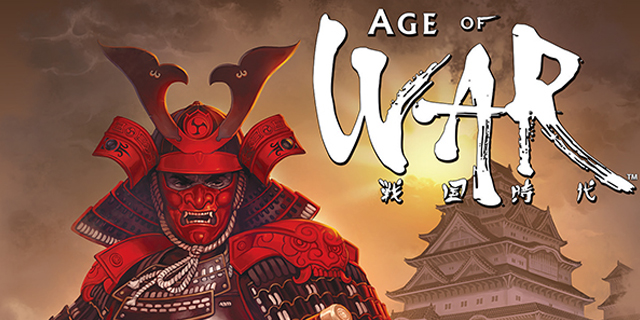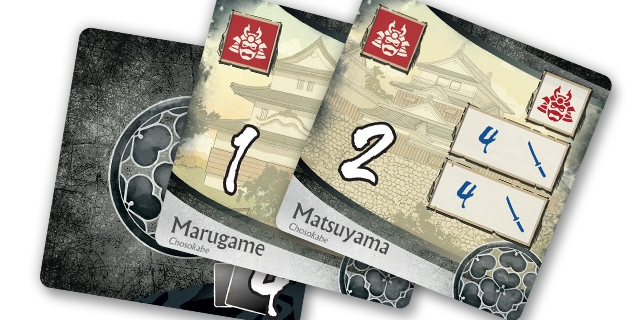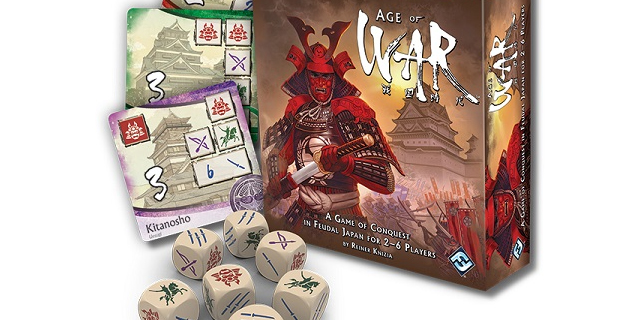
Risk is one of the all-time classics and is probably among the first five games the general populace thinks of when they hear the term “board game.” It’s also, to fans of modern board gaming, right up there with Monopoly as a horrible game design that just kills fun. That said, conquering the world with military force is still an attractive theme, so it’s no real surprise that “improved” versions of Risk have cropped up from time to time.
One such version was called Risk Express, a 2006 design by Reiner Knizia that distilled the essence of the game down to seven custom dice and some cards representing territories. Fantasy Flight Games recently took the Risk Express mechanic and used it as a base for its 2011 dice-based Cthulhu game Elder Sign. Since it already had the rights to Knizia’s design, it also repainted it with a feudal Japan skin and released it in 2014 without all of Elder Sign‘s extra baggage. Thus Risk Express has been reborn as Age of War.
On a player’s turn, they roll all the dice. These dice have symbols representing different forces in your army: infantry (with values from one through three), cavalry, archers and daimyos (leaders). Each of the territory cards has a number of lines of these same symbols. With your first roll, you must assign one or more of your dice to completing a full line on any face-up card. After rerolling the remaining dice, you must continue to complete lines on that same card. If you cannot, you sacrifice a die and continue rolling. This process continues until you either complete every line on the card or run out of dice with which to do so.

If you complete a card, you place it in front of you but keep it face-up. Other players can still place dice on it in an attempt to steal it from you, but this requires an additional daimyo result on top of the normal conquest lines. Why would you want to do this, other than spite? Because if you conquer every card of a clan (represented by colors for easy reference), you not only score bonus points but also turn those cards face-down, rendering them immune to future conquests.
Play continues until all of the cards have been claimed from the center of the table. At this point, players add up the points for the cards they have conquered and whoever has the most points wins, with ties broken by number of cards conquered. This process should take no longer than half an hour, tops. With the treacherous nature of dice, that estimate has the potential to be wildly off from game to game, but for the most part has been accurate in my experience.
Age of War is the epitome of a filler game in every respect, but that doesn’t mean it isn’t a blast to play over its brief lifespan. The tension of needing to hit specific symbols, fully half of which are literally all one-in-six chances, is as much of a rush when you succeed as it is cathartic to watch your opponents fail. Some of the cards are really hard to complete and have an incredibly small margin for error, so you have to choose your battles wisely.
There isn’t a whole lot of strategy to be found here, but it does come up from time to time. Knowing how many dice to invest toward completing a card’s infantry requirement(s) specifically is very important. Using too many too early will dramatically hurt your chances of completing it — assuming it doesn’t actually make it mathematically impossible! It’s usually best to save that line for last, but sometimes the dice just don’t fall that way.

Your most crucial decision each turn is which card to focus on after your first roll. If there’s an unclaimed card in the center that would complete a clan you obviously go for that. But what if the card you need is already claimed? Do you try to hit the extra daimyo to steal it or focus your efforts elsewhere? What if someone else has already started on a clan but your roll suggests that you get in their way by taking another card from it? Is it worth the risk, pardon the pun?
Age of War supports from two to six players, although I find it better with more. At low player counts it is too easy to do the math in the endgame and determine the best course of action, regardless of your actual roll. If it’s impossible for you to win without stealing your opponent’s card, then that’s what you obviously have to do. This math is still possible with multiple players, but at least then you probably have more options and you might open the door for someone else to swoop in. Knowing when to go for the last unclaimed card and end the game is also something worth considering.
Since Age of War is literally nothing but seven dice and about a dozen cards, it has one of the smallest boxes I have ever seen. It’s actually larger than the game really needs, but presumably the smallest available box height that would still contain the dice. This makes it perfect for carrying around and playing whenever the opportunity arises. Also perfect? The MSRP of $13. This puts Age of War in the same “insane value” range as Star Realms.
Age of War might become my go-to filler for some time to come. At the very least it’s a change of pace from the dominance of card-based fillers like No Thanks! and the like. And it certainly beats the pants off a four-hour-plus session of Risk.



















